The dynamics of news engagement on social media platforms reveal distinct preferences across different age groups. Facebook tends to attract older users, particularly those aged 30 and above, who utilize the platform for news consumption. In contrast, Twitter engages a younger audience, especially those aged 18-49, drawn by its real-time updates and trending topics.
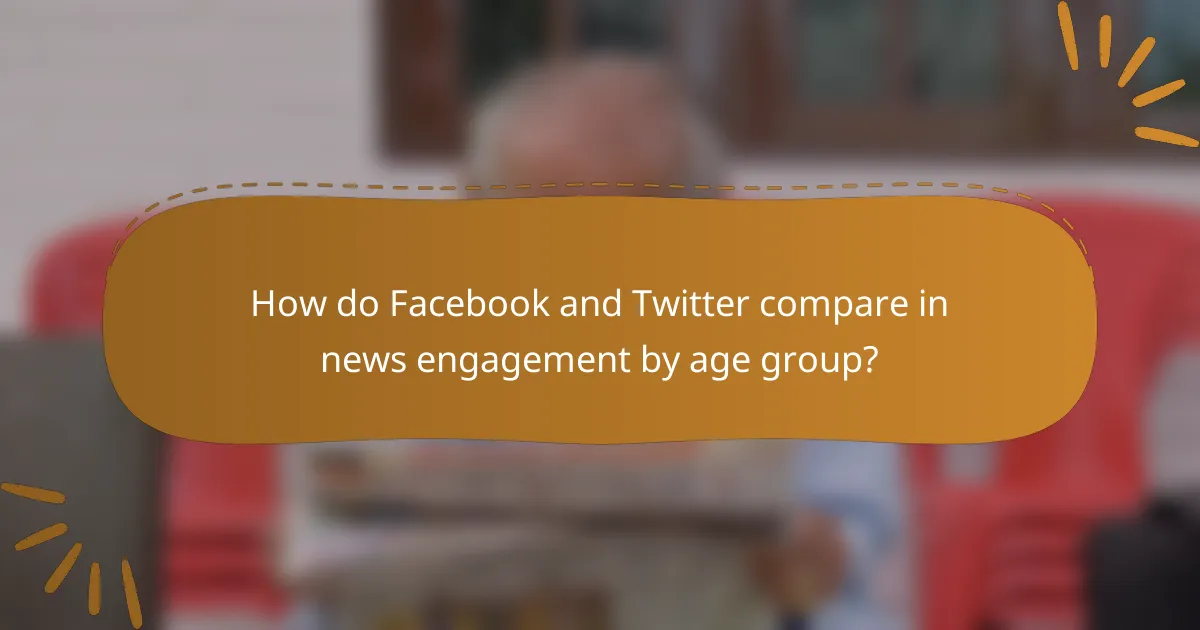
How do Facebook and Twitter compare in news engagement by age group?
Facebook generally has higher news engagement among older age groups, while Twitter attracts younger users. This difference in platform preference highlights how age influences social media usage for news consumption.
Facebook leads in older demographics
Facebook is particularly popular among users aged 30 and above, with many individuals in their 40s and 50s turning to the platform for news updates. This trend is partly due to Facebook’s user-friendly interface and community-oriented features that appeal to older audiences.
Older users often engage with news through shared articles and community discussions, making Facebook a vital source of information for this demographic. Brands targeting this age group should consider leveraging Facebook for news-related campaigns and content.
Twitter is popular among younger users
Twitter has carved out a niche among younger users, especially those in their teens and twenties. The platform’s real-time updates and concise format make it ideal for quick news consumption, appealing to a generation that values speed and brevity.
Young users often use Twitter to follow trending topics and engage in conversations about current events. Brands aiming to reach this audience should focus on creating engaging, timely content that resonates with their interests and encourages interaction.

What age groups engage with news on Facebook?
Users aged 30 and above are the primary demographic engaging with news on Facebook, with notable activity from both the 30-49 and 50+ age groups. This trend highlights the platform’s role as a significant source of news for older audiences, who often seek out information on current events and topics of interest.
Users aged 30-49 show high engagement
The 30-49 age group demonstrates strong engagement with news content on Facebook, often using the platform to stay informed about local and global events. This demographic tends to share articles and participate in discussions, making them a vital audience for news organizations.
Many users in this age range appreciate the convenience of accessing news through their social media feeds, which allows for quick updates and diverse perspectives. They are likely to follow news pages and engage with content that resonates with their interests, such as politics, technology, and lifestyle topics.
Users aged 50+ are increasingly active
Users aged 50 and older are becoming more active on Facebook, particularly in engaging with news content. This group has shown a growing interest in using social media as a tool for information, often seeking out news that affects their communities and personal lives.
As this demographic becomes more familiar with digital platforms, they are increasingly likely to interact with news articles, comment on posts, and share information with their networks. News organizations should consider tailoring their content to appeal to this audience, focusing on relevant issues such as health, retirement, and community events.
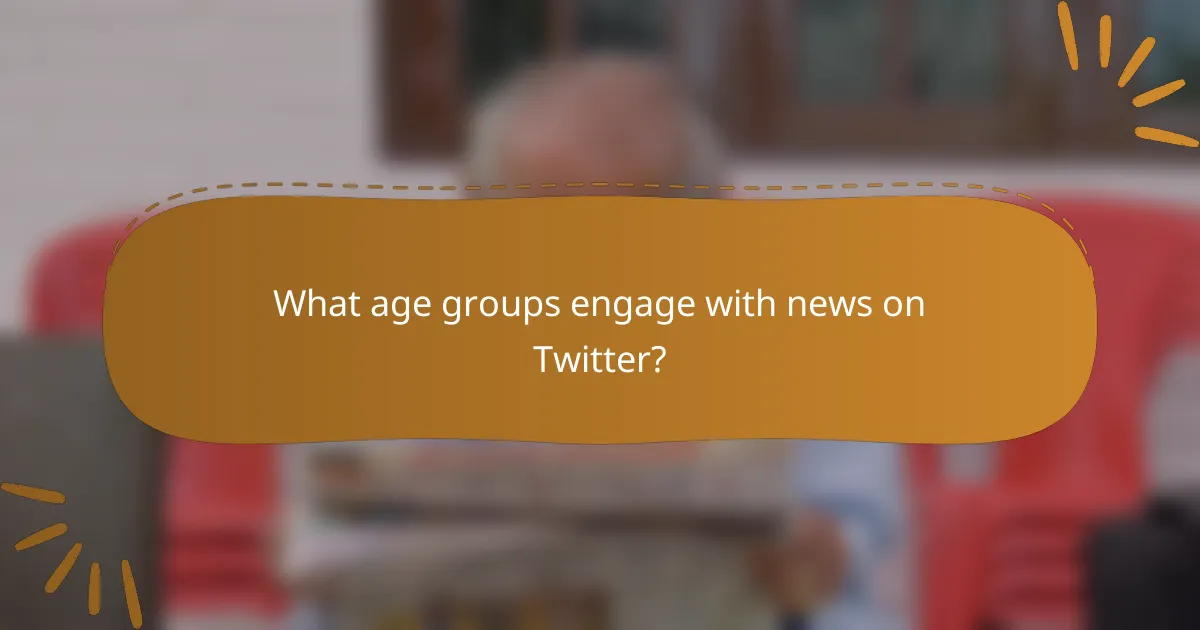
What age groups engage with news on Twitter?
Users aged 18-49 are the primary demographics engaging with news on Twitter, with younger users showing particularly high levels of interaction. This engagement is driven by the platform’s real-time updates and trending topics, appealing to those seeking immediate news access.
Users aged 18-29 dominate engagement
The 18-29 age group is the most active demographic on Twitter when it comes to news engagement. They frequently use the platform to stay informed about current events, often sharing and discussing news articles with their peers.
This group is characterized by a preference for quick, digestible content, such as tweets and threads that summarize news stories. Their engagement is often influenced by social media trends and the viral nature of content, making them key players in shaping news narratives.
Users aged 30-49 are also significant
Users aged 30-49 represent a substantial portion of Twitter’s news engagement as well. This demographic tends to seek more in-depth coverage and analysis, often following news organizations and journalists for comprehensive updates.
While not as dominant as the younger group, this age range engages with news through retweets and discussions, valuing credible sources and detailed reporting. Their engagement patterns reflect a balance between immediacy and depth, making them an important audience for news outlets targeting a more mature readership.
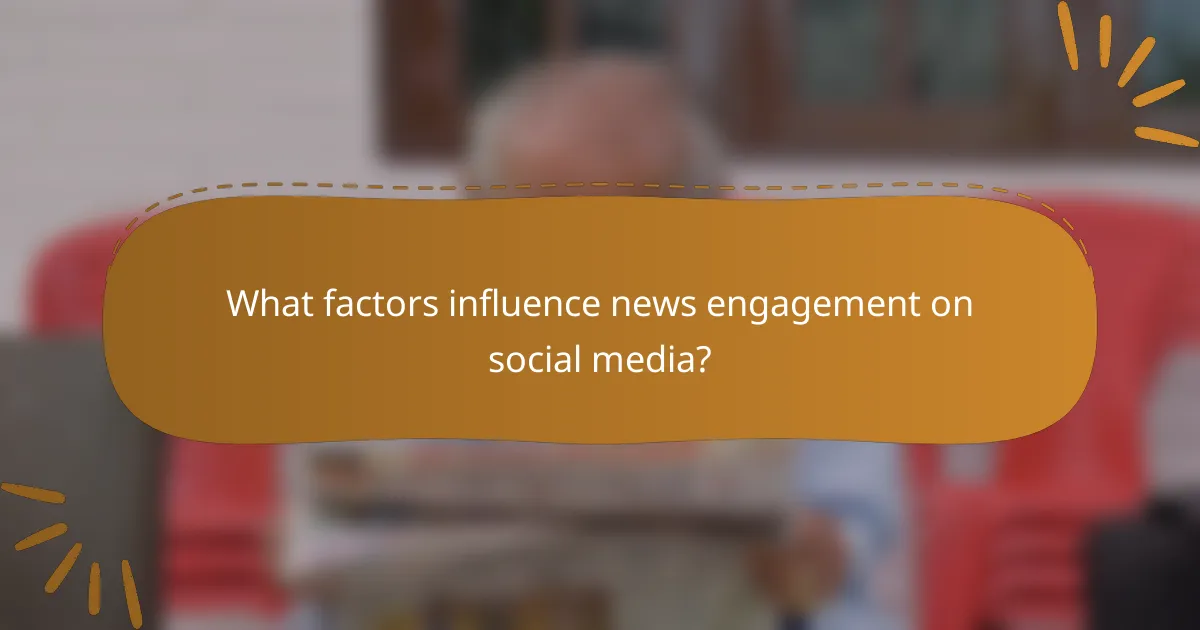
What factors influence news engagement on social media?
News engagement on social media is influenced by various factors, including content type, user interaction, and demographic preferences. Understanding these elements can help platforms like Facebook and Twitter tailor their news offerings to better capture audience interest.
Content type affects engagement levels
The type of content shared significantly impacts how users engage with news on social media. Visual content, such as videos and infographics, tends to attract more attention compared to text-heavy posts. For instance, posts with images can increase engagement rates by a notable margin, making them more likely to be shared and commented on.
Additionally, breaking news alerts and updates often generate higher engagement than general news articles. Users are more inclined to interact with timely, relevant information that affects their lives or communities. Therefore, platforms should prioritize diverse content formats to maximize user engagement.
User interaction and feedback drive interest
User interaction plays a crucial role in driving interest in news content on social media. Likes, shares, and comments create a feedback loop that encourages further engagement. When users see their peers interacting with a post, they are more likely to engage themselves, fostering a sense of community and shared interest.
Moreover, algorithms on platforms like Facebook and Twitter often prioritize content with higher interaction rates, making it more visible to a broader audience. To enhance engagement, users and content creators should actively encourage discussions and respond to comments, creating a more dynamic news-sharing environment.
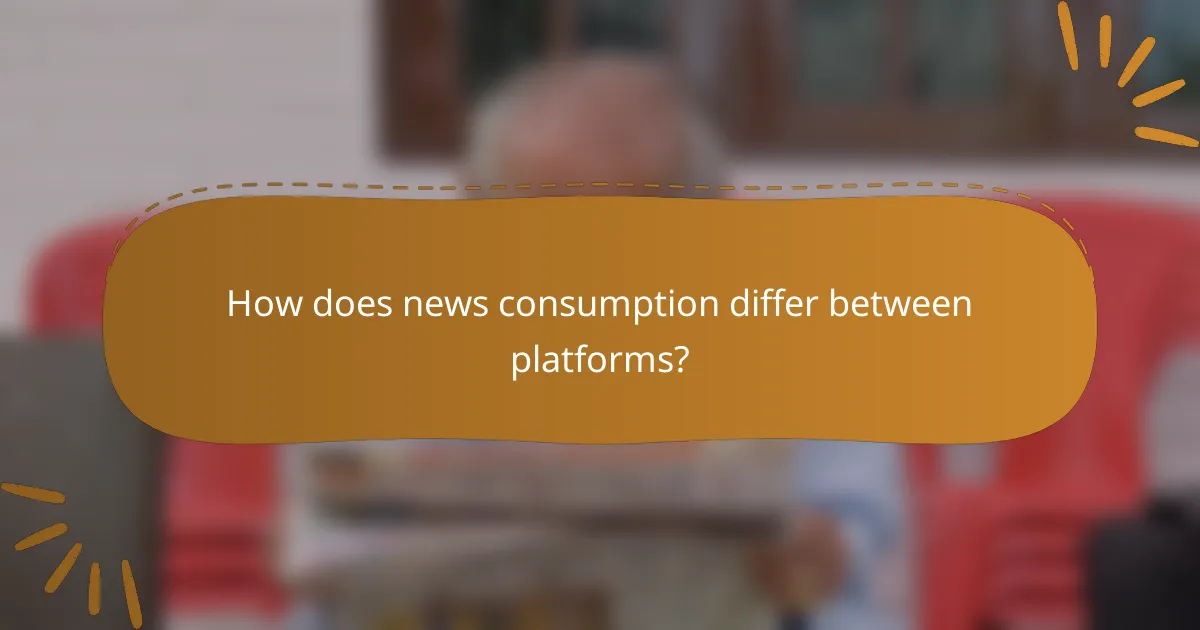
How does news consumption differ between platforms?
News consumption varies significantly between Facebook and Twitter, with each platform catering to different user preferences and behaviors. Facebook tends to support longer articles and multimedia content, while Twitter emphasizes quick updates and concise messaging.
Facebook favors longer articles and videos
On Facebook, users are more likely to engage with in-depth articles and video content. This platform allows for longer posts, which can include detailed analyses, opinion pieces, and comprehensive news stories. As a result, users often spend more time reading and interacting with content that provides a deeper understanding of news topics.
For example, news organizations often share articles that exceed 1,000 words, accompanied by videos that further explain complex issues. This format appeals particularly to users seeking thorough information and context.
Twitter promotes real-time updates and brevity
Twitter is designed for quick, real-time updates, making it ideal for breaking news and immediate reactions. The character limit encourages brevity, prompting users to share concise messages, often with links to longer articles for further reading. This platform is favored by those who want to stay informed on current events without delving into lengthy texts.
Users can quickly scroll through tweets, allowing them to absorb information in a matter of seconds. This fast-paced environment suits audiences who prefer immediate insights and updates over detailed narratives.
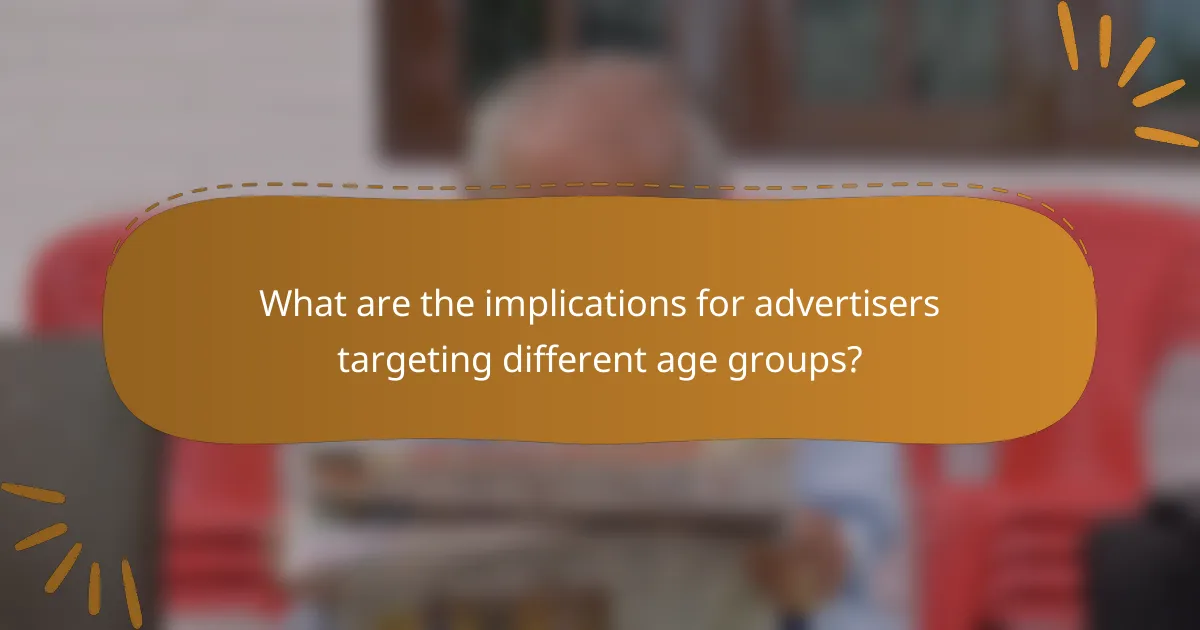
What are the implications for advertisers targeting different age groups?
Advertisers must consider age group preferences when targeting audiences on social media platforms like Facebook and Twitter. Understanding these differences can enhance engagement and improve return on investment (ROI) for campaigns aimed at specific demographics.
Targeted ads on Facebook yield higher ROI for older users
Older users on Facebook tend to engage more with targeted ads, leading to a higher ROI for advertisers. This demographic often values detailed information and is more likely to respond positively to well-crafted advertisements that resonate with their interests and needs.
For example, campaigns promoting health products or retirement planning services can see significant engagement from users aged 50 and above. Advertisers should focus on creating content that speaks directly to the concerns and lifestyles of older adults, using clear messaging and relevant visuals.
Twitter ads are effective for reaching younger audiences
Twitter is particularly effective for reaching younger audiences, who are more inclined to engage with real-time content and trending topics. Advertisers can leverage this by creating ads that tap into current events or popular culture, making them more relatable to users aged 18 to 34.
Utilizing concise messaging and eye-catching visuals can enhance engagement rates. Brands should consider using hashtags and participating in trending conversations to maximize visibility and relevance among younger users, ensuring that their ads feel organic and timely.
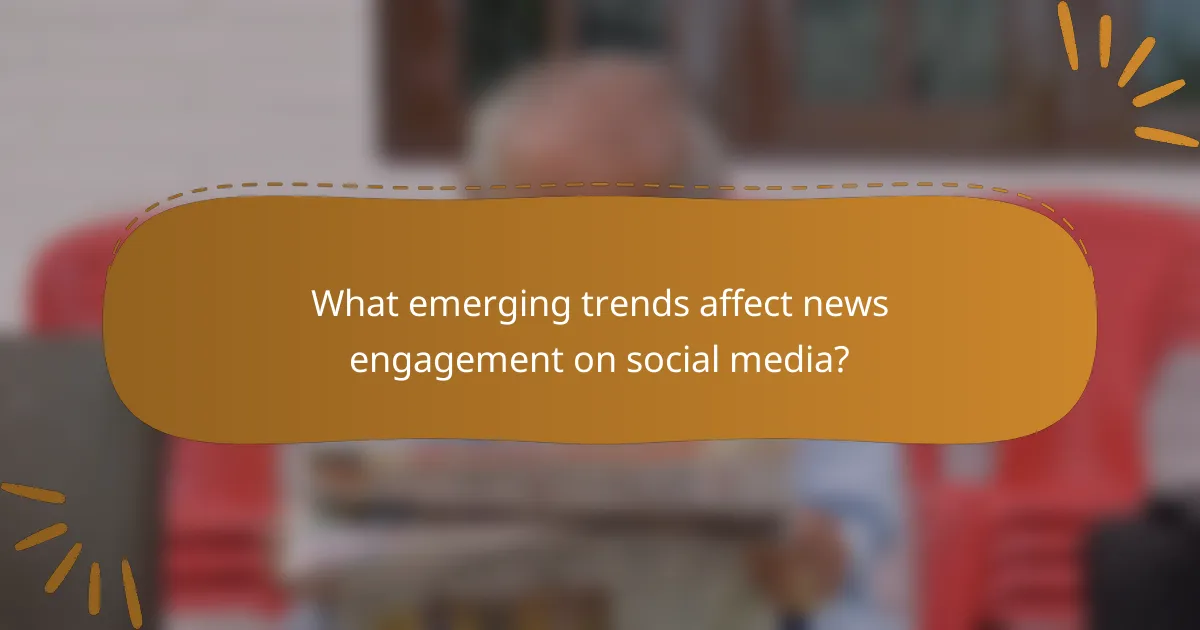
What emerging trends affect news engagement on social media?
Emerging trends such as increased video content and personalized news feeds significantly influence how users engage with news on social media platforms. These trends cater to user preferences, making news consumption more appealing and tailored to individual interests.
Increased use of video content
Video content has become a dominant format for news engagement, especially among younger audiences. Platforms like Facebook and Twitter prioritize video posts, leading to higher visibility and interaction rates compared to text-based updates.
Short, engaging videos that summarize news stories can capture attention quickly, often leading to higher shares and comments. For instance, news organizations frequently use live streams or short clips to report breaking news, which can attract thousands of views within minutes.
Growth of personalized news feeds
Personalized news feeds allow users to see content tailored to their interests, enhancing engagement. Algorithms analyze user behavior to prioritize news stories that align with individual preferences, resulting in a more relevant news experience.
This trend can lead to increased time spent on platforms, as users are more likely to engage with content that resonates with them. However, it also raises concerns about echo chambers, where users may only encounter viewpoints that reinforce their existing beliefs. Balancing personalization with diverse content is crucial for a well-rounded news diet.
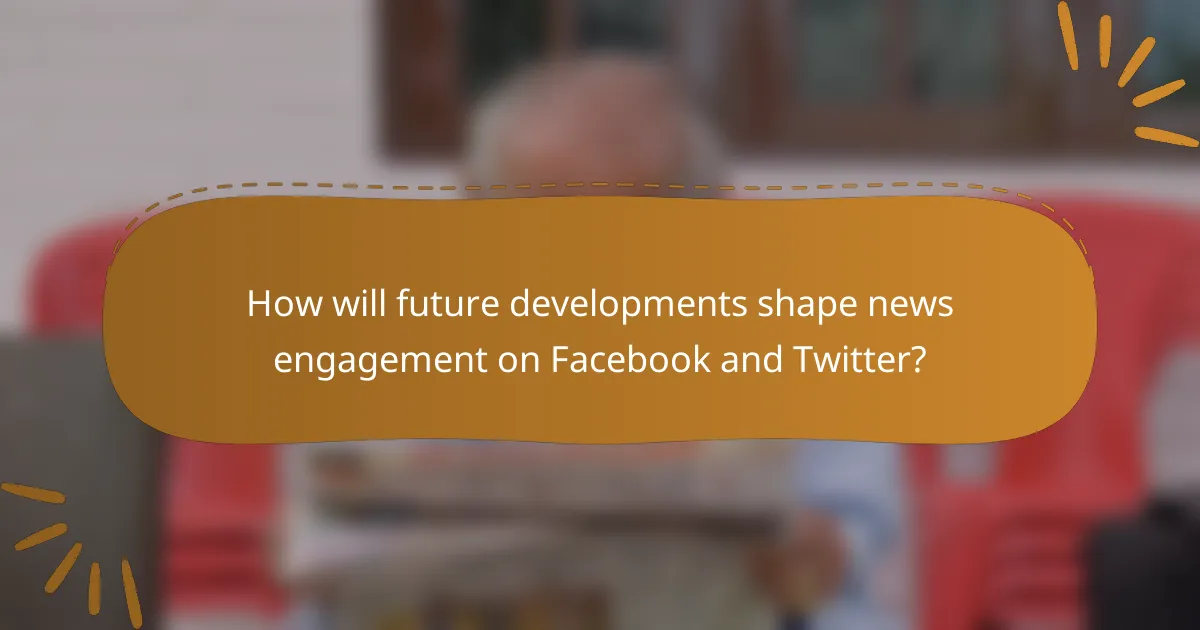
How will future developments shape news engagement on Facebook and Twitter?
Future developments in technology and user demographics will significantly influence how news is engaged with on Facebook and Twitter. As platforms evolve, they will adopt new strategies to cater to changing user preferences and enhance the overall experience.
AI-driven content curation will enhance user experience
AI-driven content curation will allow Facebook and Twitter to deliver more personalized news feeds, improving user engagement. By analyzing user behavior and preferences, these platforms can prioritize relevant news articles, making it easier for users to find content that interests them.
For example, algorithms may highlight local news for users in specific regions or tailor trending topics based on individual interests. This targeted approach can lead to higher engagement rates, as users are more likely to interact with content that resonates with them.
Shifts in user demographics will redefine engagement strategies
As user demographics shift, particularly with younger generations increasingly favoring visual content, Facebook and Twitter will need to adapt their engagement strategies. For instance, younger users may prefer video news clips or interactive posts over traditional text-based articles.
To effectively engage these demographics, platforms might implement features that allow for more dynamic content sharing, such as live discussions or polls related to current events. Understanding these trends will be crucial for news organizations looking to maintain relevance and foster user interaction.
